Statistics: Sand & Gravel Operators
On This Page
Introduction
The following maps, graphs, and tables present data for Sand & Gravel Mine Operators. The information is organized by Mines, Employees, Fatalities, and Injuries. The Mines section contains information on the number and location of the mining operations. The Employees section details the number of employees and the number of employee hours. The Fatalities section describes the number and rate of fatalities, the number and rate by work locations, and the number of fatalities by accident class. The Injuries section presents the number and rate of nonfatal lost-time injuries, the number and rate by work locations, and the number of injuries by accident class. Note: Sand & gravel mining occurs at surface locations only. Data source: Mine Safety and Health Administration (MSHA). See Statistical Methodology for further details. Additional Mining Facts for each commodity are available from 2000 through 2015.
Mines
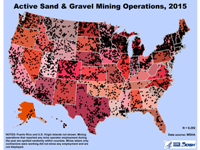 Active Sand & Gravel Mining Operations, 2015: Map of the United States displaying the locations of active sand & gravel mining operations spotted randomly within counties in 2015. Active mines are mining operations that reported mine operator employment during the year. There were 6,292 sand & gravel mines. Mines at which only contractors were working did not show any employment and are not displayed.
Active Sand & Gravel Mining Operations, 2015: Map of the United States displaying the locations of active sand & gravel mining operations spotted randomly within counties in 2015. Active mines are mining operations that reported mine operator employment during the year. There were 6,292 sand & gravel mines. Mines at which only contractors were working did not show any employment and are not displayed.
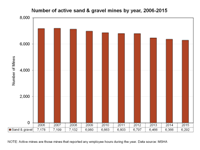 Number of Active Sand & Gravel Mines by Year, 2006-2015: Graph displaying the number of active mines for a 10-year period from 2006 through 2015. Active mines are those mines that reported any mine operator employee hours during the year. The number of active sand & gravel mines has decreased over the period from 7,178 in 2006 to 6,292 in 2015.
Number of Active Sand & Gravel Mines by Year, 2006-2015: Graph displaying the number of active mines for a 10-year period from 2006 through 2015. Active mines are those mines that reported any mine operator employee hours during the year. The number of active sand & gravel mines has decreased over the period from 7,178 in 2006 to 6,292 in 2015.
Employees
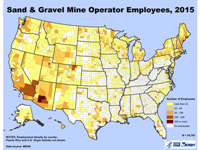 Sand & Gravel Mine Operator Employees, 2015: Map of the United States displaying employment density by county of the 34,781 sand & gravel mine operator employees in 2015. A graduated color ramp is used to symbolize densities of less than 25 employees, 25 to 49 employees, 50 to 199 employees, 200 to 499 employees, and 500 or more employees.
Sand & Gravel Mine Operator Employees, 2015: Map of the United States displaying employment density by county of the 34,781 sand & gravel mine operator employees in 2015. A graduated color ramp is used to symbolize densities of less than 25 employees, 25 to 49 employees, 50 to 199 employees, 200 to 499 employees, and 500 or more employees.
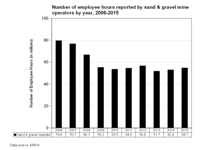 Number of Employee Hours Reported by Sand & Gravel Mine Operators by Year, 2006-2015: Graph displaying the number of sand and gravel mine operator employee hours reported from 2006 through 2015. The number of employee hours has varied with the highest number occurring in 2006 when 79.6 million were reported to the lowest number occurring in 2013 when 51.7 million hours were reported. The largest decline in hours was from 2006 when 79.6 million hours were reported to 2009 when the hours were 55.2 million. In 2015, there were 54.7 million employee hours reported.
Number of Employee Hours Reported by Sand & Gravel Mine Operators by Year, 2006-2015: Graph displaying the number of sand and gravel mine operator employee hours reported from 2006 through 2015. The number of employee hours has varied with the highest number occurring in 2006 when 79.6 million were reported to the lowest number occurring in 2013 when 51.7 million hours were reported. The largest decline in hours was from 2006 when 79.6 million hours were reported to 2009 when the hours were 55.2 million. In 2015, there were 54.7 million employee hours reported.
Fatalities
Number of Sand & Gravel Operator Occupational Mining Fatalities by Year, 2006-2015: Graph displaying the number of occupational mining fatalities, excluding office employees, from 2006 through 2015. Rates are not computed when there are a small number of events. Fatalities varied over the period with the highest number being 7 in 2014. The years with the least number of fatalities were 2010 and 2013 when 1 fatality occurred. In 2015 there were 4 fatalities reported.
Injuries
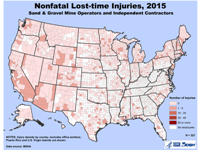 Nonfatal Lost-time Injuries, 2015 (Sand & Gravel Mine Operators and Independent Contractors): Map of the United States displaying nonfatal lost-time injury density by county for 327 sand & gravel mine operator and contractor injuries during 2015. Office workers are excluded. A graduated color ramp is used to symbolize densities of zero injuries, 1 to 9, 10 to 29, 30 to 49, and 50 or more injuries.
Nonfatal Lost-time Injuries, 2015 (Sand & Gravel Mine Operators and Independent Contractors): Map of the United States displaying nonfatal lost-time injury density by county for 327 sand & gravel mine operator and contractor injuries during 2015. Office workers are excluded. A graduated color ramp is used to symbolize densities of zero injuries, 1 to 9, 10 to 29, 30 to 49, and 50 or more injuries.
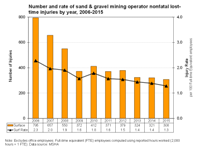 Number and Rate of Sand & Gravel Mining Operator Nonfatal Lost-time Injuries by Year, 2006-2015: Graph displaying the number and rate of sand & gravel mining operator nonfatal lost-time injuries, excluding office employees, from 2006 through 2015. Full-time equivalent (FTE) employees are based on 2,000 employee hours worked per year. The rates and numbers have trended down over the period. The highest rate was 2.3 nonfatal lost-time injuries per 100 FTEs in 2006 to a low rate of 1.3 in 2015. The highest number of injuries occurred in 2006 when 795 injuries were reported. The year during the period with the lowest number of injuries was 2015 when 308 injuries occurred.
Number and Rate of Sand & Gravel Mining Operator Nonfatal Lost-time Injuries by Year, 2006-2015: Graph displaying the number and rate of sand & gravel mining operator nonfatal lost-time injuries, excluding office employees, from 2006 through 2015. Full-time equivalent (FTE) employees are based on 2,000 employee hours worked per year. The rates and numbers have trended down over the period. The highest rate was 2.3 nonfatal lost-time injuries per 100 FTEs in 2006 to a low rate of 1.3 in 2015. The highest number of injuries occurred in 2006 when 795 injuries were reported. The year during the period with the lowest number of injuries was 2015 when 308 injuries occurred.
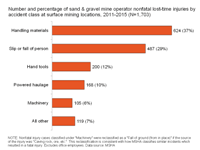 Number and Percentage of Sand & Gravel Operator Nonfatal Lost-time Injuries by Accident Class at Surface Mining Locations, 2011-2015: Graph displaying the distribution of nonfatal lost-time injuries by accident class for sand & gravel operators at surface mining locations for the period from 2011 through 2015. There were a total of 1,703 lost-time injuries, excluding office employees. "Handling materials" had 37.0%, "Slip or fall of person" had 29.0%, "Hand tools" had 12.0%, "Powered haulage" had 10.0%, and "Machinery" had 6.0% of the nonfatal lost-time injuries. Note that nonfatal injury cases classified under machinery were reclassified as a fall of ground (from in place) if the source of the injury was caving rock, ore, etc. This reclassification is consistent with how MSHA classifies similar incidents which resulted in a fatal injury. The “All other” category had 7.0% of the nonfatal lost-time injuries during the 5-year period. Note that the sum of percentages may not equal 100 due to independent rounding.
Number and Percentage of Sand & Gravel Operator Nonfatal Lost-time Injuries by Accident Class at Surface Mining Locations, 2011-2015: Graph displaying the distribution of nonfatal lost-time injuries by accident class for sand & gravel operators at surface mining locations for the period from 2011 through 2015. There were a total of 1,703 lost-time injuries, excluding office employees. "Handling materials" had 37.0%, "Slip or fall of person" had 29.0%, "Hand tools" had 12.0%, "Powered haulage" had 10.0%, and "Machinery" had 6.0% of the nonfatal lost-time injuries. Note that nonfatal injury cases classified under machinery were reclassified as a fall of ground (from in place) if the source of the injury was caving rock, ore, etc. This reclassification is consistent with how MSHA classifies similar incidents which resulted in a fatal injury. The “All other” category had 7.0% of the nonfatal lost-time injuries during the 5-year period. Note that the sum of percentages may not equal 100 due to independent rounding.
See Also
- Analysis of Roof Bolt Systems
- Elastic and Shear Moduli of Coal Measure Rocks Derived from Basic Well Logs Using Fractal Statistics and Radial Basis Functions
- Electromagnetic Noise in Itmann Mine
- Electromagnetic Noise in Lucky Friday Mine
- A Feasibility Study for the Detection of Weak Electromagnetic Signal/ Bursts With Hard-Limited Arrays
- Methane Emission from U.S. Coal Mines, A Survey
- Mining Fact Sheets
- Mining Facts - 2015
- Peak Methane Concentrations During Coal Mining: An Analysis
- Statistical Methodology
- Statistics: Stone Operators
- The Status of Mine Fire Research in the United States
- Stone and Sand & Gravel Industry Sector
- Underground Coal Mining Disasters and Fatalities: United States, 1900-2006
- Page last reviewed: 3/22/2017
- Page last updated: 3/22/2017
- Content source: National Institute for Occupational Safety and Health, Mining Program


 ShareCompartir
ShareCompartir